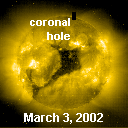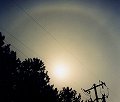|   SPACE WEATHER SPACE WEATHER
Current
Conditions
Solar Wind
speed: 370.1 km/s
density:15.0 protons/cm3
explanation | more data
Updated: Today at 2245 UT
X-ray Solar Flares
6-hr max: C2 1830 UT Mar03
24-hr: C3 0205 UT Mar03
explanation | more data
Updated: Today at 2245 UT
Daily Sun: 03 Mar '02 
Sunspot 9845 has a beta-gamma magnetic field that harbors energy for M-class solar flares. Image credit: SOHO/MDI
The Far Side of the Sun

This holographic image reveals a sunspot complex on the far side of the Sun. Image credit: SOHO/MDI
Sunspot Number: 153
More about sunspots
Updated: 02 Mar 2002 Interplanetary Mag. Field
Btotal: 18.6 nT
Bz: 3.1 nT south
explanation | more data
Updated: Today at 2246 UT Coronal Holes:

A large coronal hole is crossing the Sun's central meridian. Solar wind gusts could buffet Earth's magnetosphere as early as March 4th. Image credit: SOHO Extreme UV Telescope.
More about coronal holes
Radio Meteor Rate
24 hr max: 23 per hr
Listen to the Meteor Radar!
Updated: 02 Mar 2002
 SPACE WEATHER SPACE WEATHER
NOAA
Forecasts
Solar Flares: Probabilities for a medium-sized (M-class) or a major (X-class) solar flare during the next 24/48 hours are tabulated below.
Updated at 2002 Mar 03 2200 UTC
| FLARE | 0-24 hr | 24-48 hr | | CLASS M | 40 % | 40 % | | CLASS X | 01 % | 01 % |
Geomagnetic Storms: Probabilities for significant disturbances in Earth's magnetic field are given for three activity levels: active, minor storm, severe storm
Updated at 2002 Mar 03 2200 UTC Mid-latitudes | 0-24 hr | 24-48 hr | | ACTIVE | 25 % | 35 % | | MINOR | 10 % | 15 % | | SEVERE | 01 % | 01 % |
High latitudes | 0-24 hr | 24-48 hr | | ACTIVE | 30 % | 40 % | | MINOR | 10 % | 15 % | | SEVERE | 01 % | 01 % |

Web server provided by
VPS Hosting | What's Up in Space -- 3 Mar 2002
Subscribe to Space Weather News! AURORA WARNING: Earth will soon enter a high-speed solar wind stream flowing from a coronal hole on the Sun. High-latitude sky watchers -- e.g., those in northern Europe, Canada, and the northern tier of US states -- should be alert for Northern Lights after local sunset on March 4th and 5th.  NORTHERN LIGHTS: On Feb. 28th at 1700 UT, the interplanetary magnetic field (IMF) near Earth tilted south -- a condition that often sets the stage for Northern Lights. The event triggered a minor G1-class geomagnetic storm and high-latitude auroras. Click for images. NORTHERN LIGHTS: On Feb. 28th at 1700 UT, the interplanetary magnetic field (IMF) near Earth tilted south -- a condition that often sets the stage for Northern Lights. The event triggered a minor G1-class geomagnetic storm and high-latitude auroras. Click for images.
SOLAR BLAST: An impressive prominence erupted near the Sun's southeastern limb on March 2nd. The explosion also hurled a bright coronal mass ejection into space -- but apparently not toward Earth.  RING AROUND THE MOON: Winter is a good time to spot halos in the sky. This one, recorded by Brian Larmay on March 1st, was formed by moonlight reflected from ice crystals in high-altitude clouds over Wisconsin. Says Larmay: "I briefy saw auroras, too, but the high thin clouds made them look like light pollution." RING AROUND THE MOON: Winter is a good time to spot halos in the sky. This one, recorded by Brian Larmay on March 1st, was formed by moonlight reflected from ice crystals in high-altitude clouds over Wisconsin. Says Larmay: "I briefy saw auroras, too, but the high thin clouds made them look like light pollution."
BRIGHT MOONSHINE: Last week many sky watchers enjoyed the biggest and brightest full Moon of 2002. Photographer Ken Florentino captured this lovely image of the extra-wide Moon setting over Pike's Peak as dawn broke on Feb. 28th.  WEB LINKS: NOAA FORECAST | GLOSSARY | SPACE WEATHER TUTORIAL | LESSON PLANS | BECOME A SUBSCRIBER | 
Potentially Hazardous Asteroids (PHAs) are space rocks larger than approximately 100m that can come closer to Earth than 0.05 AU. None of the known PHAs are on a collision course with our planet, although astronomers are finding new ones all the time.
On 3 Mar 2002 there were 383 known Potentially
Hazardous Asteroids Feb.-Mar. 2002 Earth-asteroid encountersNotes: LD is a "Lunar Distance." 1 LD = 384,401 km, the distance between Earth and the Moon. 1 LD also equals 0.00256 AU. MAG is the visual magnitude of the asteroid on the date of closest approach. ASTEROID FLYBY: On Feb. 6, 2002, newly-discovered asteroid 2002 BG25 flew past Earth. There was no danger of a collision; the 400-meter wide space rock was 20 times farther away than the Moon. Asteroid watcher John Rogers captured these videos of the flyby from the Camarillo Observatory near Los Angeles: 1.0 MB (asf); 1.8 MB (mpg); 4.3 MB (mpg). 
- GONE JUPITER: On Feb. 22, 2002, the Moon had a close encounter with Jupiter. [gallery]
- GONE SATURN: On Feb. 20, 2002, the Moon glided in front of Saturn and its mysterious rings. [gallery]
- HOT COMET: Periodic comet 96P/Machholz put on a dazzling show as it swung by the Sun on Jan. 8, 2002.
- ASTEROID FLYBY: Asteroid 2001 YB5 raced past Earth on Jan. 7, 2002, only two times farther away than the Moon. [gallery]
- SUBTLE ECLIPSE: The Moon dipped into the outskirts of Earth's shadow on Dec. 30, 2001. [gallery]
- MOON & SATURN: The Moon keeps getting in the way of Saturn! See the series of close encounters here.
- CHRISTMAS LIGHTS: On Christmas Eve, 2001, a solar wind stream triggered Northern Lights. [gallery]
- SOLAR ECLIPSE: Sky watchers in Hawaii and most parts of North America experienced a partial solar eclipse on Dec. 14th. [gallery]
- BRIGHT ASTEROID: Videos and images of 1998 WT24 -- a big and bright near-Earth asteroid that came close to our planet on Dec. 16, 2001. [gallery]
- NORTHERN LIGHTS: On Nov. 24th a pair of coronal mass ejections swept past Earth and triggered worldwide auroras.
- LEONIDS 2001: Some people saw it. Others heard it. In either case, they'll never forget it: The 2001 Leonid meteor storm.
- PERSEIDS 2001: Perseid watchers on August 12th spotted meteors, auroras, and a disintegrating Russian rocket! [gallery]
- MORNING PLANETS: In July and Aug. 2001, the Moon, Jupiter, Saturn, Venus, and Mercury put on a dazzling early-morning sky show. [gallery]
- ECLIPSE SAFARI: Onlookers cried out in delight on June 21, 2001, when the Moon covered the African Sun, revealing the dazzling corona. [gallery]
- TOTAL LUNAR ECLIPSE: On Jan. 9, 2001, the full Moon glided through Earth's copper-colored shadow. [gallery]
- CHRISTMAS ECLIPSE: Sky watchers across North America enjoyed a partial solar eclipse on Christmas Day 2000 [gallery]
- LEONIDS 2000: Observers around the globe enjoyed three predicted episodes of shooting stars. [gallery]
 Nov. 7 , 2001: What Lies beneath a Sunspot -- Awesome plasma hurricanes were one of the surprises revealed when scientists peered beneath the stormy surface of our star. Nov. 7 , 2001: What Lies beneath a Sunspot -- Awesome plasma hurricanes were one of the surprises revealed when scientists peered beneath the stormy surface of our star. Oct. 26 , 2001: 'tis the Season for Auroras -- Autumn is a good time to spot Northern Lights. Oct. 17, 2001: Halley's Comet Returns ... in bits and pieces -- The annual Orionid meteor shower peaks on October 21st. Aug. 9, 2001: Horse Flies and Meteors -- Like bugs streaking down the side window of a moving car, long and colorful Perseid Earthgrazers could put on a remarkable show on August 11th. July 27, 2001: Meteorites Don't Pop Corn -- A fireball that dazzled Americans on July 23rd probably didn't scorch any cornfields, contrary to widespread reports. June 12, 2001: The Biggest Explosions in the Solar System -- NASA's HESSI spacecraft aims to unravel an explosive mystery: the origin of solar flares. |

